[ad_1]
In its report, the Akinola Aguda Panel recommended the transfer of the capital from Lagos to Abuja which is the geographical centre of the country. It is located in the North, because of the overwhelming size of the North in comparison with the East and West put together. One of the aims of the creation of the new capital was to make it to belong to all the citizens.
The whole FCT would be transformed to be akin to a virgin land to be termed as a ‘no-man’s land’, so that Nigerian citizens would have equal rights in the nation’s capital territory.
Consequently, the Aguda report included a recommendation that the entire original inhabitants located within the 8,000 km² that made up the Federal Capital Territory should be totally evacuated to their parent states, to avoid rendering any community “stateless”.
SPONSOR AD
Therefore, irrespective of the FCT’s location in the North, the ‘no-man’s’ land’ concept should allay the fears of northerner’s domination, which may arise from the citizens from the other regional blocks. However, when the financial estimate of the total evacuation of the whole FCT original population was made, it was discovered to be very huge and would be more than the cost of building the federal capital city itself.
The federal government then opted for resettlement in stages, in order to save cost. Only the community that would be affected by physical development would be resettled. Another challenge to the government was another argument by the original inhabitants. That, irrespective of the consideration of Abuja as a ‘no-man’s land’, a great majority of the community prefer to remain behind rather than being relocated to their parent states. They should also have that equal right as Nigerian citizens to live in the FCT. In other words, why should other Nigerians be allowed to come in while they are forced to leave? Invariably, it would be an infringement of their fundamental human rights as citizens.
That policy of mandatory evacuation was thus revisited and the communities were given the choice of either to be resettled in their parent states or within the FCT. With the change of policy to retain these people within the FCT, the issue of ‘statelessness’ arose because the original inhabitants cannot claim any state if they chose to remain in the FCT.
The Aguda Panel report, paragraph 6.37 states that, “no ethnic group or people should be rendered ‘stateless’ as a result of losing their land to the Capital Territory”. Faced with such a difficult task, the Shehu Shagari administration in 1980 set up a Presidential Committee on the Resettlement of the Inhabitants of the Federal Capital Territory under the chairmanship of Senator A. D. Rufa’i.
The terms of reference, among others, were to determine priorities for mandatory resettlement at places of the inhabitants’ choice and at the expense of the federal government; to determine the number of inhabitants who wish to move out voluntarily from Federal Capital Territory; to bring up a plan for the phasing of movement and resettlement in accordance with available funds, and to determine the extent of federal government assistance; to determine priority of resettlement of inhabitants in peripheral towns and villages.
All these were aimed at freeing the Phase I of the city from all encumbrances. Because at the prevailing circumstances, the Phase I was the priority, and there were local communities within. These local communities were; Wuse, Asokoro, Garki, Maitama, Kurunduma, Karon Majigi (now falsely called Karmajiji), Katampe, Mabushi, Shishipe and other villages. With the exception of Garki and other few individuals in the rest, most of these communities opted to be resettled outside the FCT to escape the danger of being stateless in the Nigerian federation. Hence the creation and their resettlement at Sabon Wuse, headquarters of Tafa Local Government in Niger State, and New Karu in the former Plateau, now Nasarawa State.
Others whose abodes were affected by the development of the Phase I and opted to be resettled within the FCT were resettled at Kubwa. The federal government was able to address the encumbrances that were against the development of the whole of Phase I of the city, by completely resettling the original inhabitants to places within and outside the FCT, the exception was only Garki Village, which is waiting for the completion of the resettlement projects in various places within the FCT.
The challenges in Phase II and the others are more daunting. One of our brothers from Garki narrated a prediction to us made by an Islamic cleric, who visited his father a few years before the declaration of Abuja as the new federal capital. Perhaps that is why Garki Village is still remaining in the city, as believed by its people.
To be continued.
Do you want to share a story with us? Do you want to advertise with us? Do you need publicity for a product, service, or event? Contact us on WhatsApp +2348183319097 Email: platformtimes@gmail.com
We are committed to impactful investigative journalism for human interest and social justice. Your donation will help us tell more stories. Kindly donate any amount HERE




